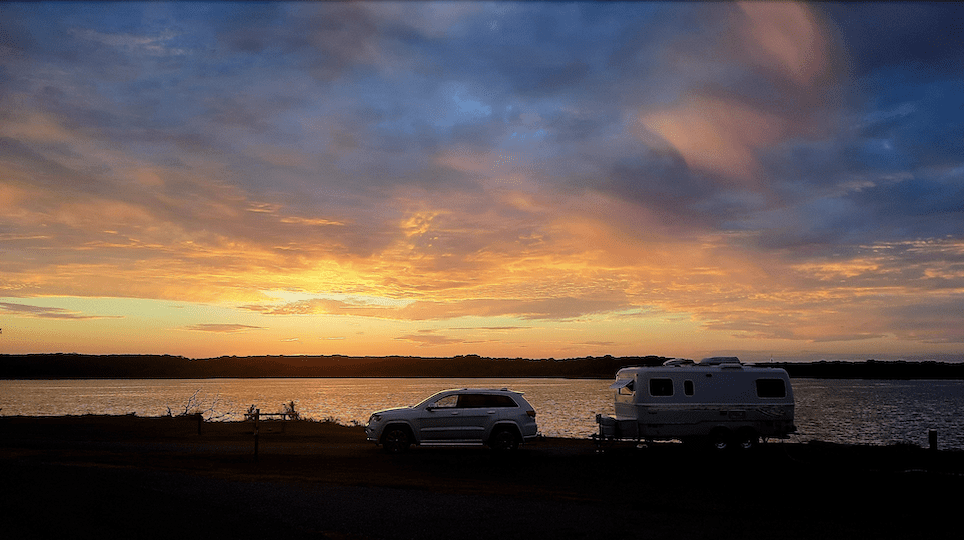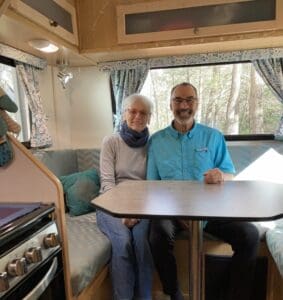How to Be Safe on the Road at Night in Your RV
To some, driving at night is a norm. Some may consider it an adventure, while others may call it a disaster. Whatever the case is, when you have to drive at night, it is a priority to ensure and maintain safety throughout the trip. When driving a large vehicle such as an RV, there are certain measures to make sure you are safe on the road at night.
Before hitting the road at night, you want to ensure that your windshield is clear and clean, both in and out. This way, you can have an optimum vision with little to no obstructions. There are many other tips to ensure safety on the road at night in your RV. This post will expose you to many of them. However, before we get into it, let’s check out the advantages and disadvantages of night driving in your RV.

Pros of Driving Your RV at Night
Driving your RV at night is not as bad as some may paint it to be. In fact, there are some advantages to it.
Fewer Cars on the Road
This is the most important advantage of driving your RV at night. At night, there are fewer cars on the road. In other words, there will be less traffic. More so, driving your RV on a congested road can be stressful, given that it may be difficult to maintain contact with your side mirrors with all the vehicles entering, exiting, and intercepting. Though driving at night doesn’t stop this with headlights of other vehicles, you can easily spot them.
Less Wind
Heavy wind is a factor that makes the road unsafe for driving, especially when handling a big vehicle. It blows you all over the road and makes controlling somewhat tricky. Winds are heavier before sunset and lesser at night.
Less Stressful and More Peaceful
The sun is not the only thing that goes down after dark. The kids, too, tend to wind down and sleep. This allows for a quieter and more peaceful drive.
Cons of Driving Your RV at Night
It is a popular thought that driving at night is not safe. Here are some of the reasons for this mindset.
Oncoming Traffic and Headlights
Headlights make vehicles visible at night. However, while vehicles are visible, everything without illumination, including animals, becomes invisible. Remain concentrated, observe the road closely, and keep a reasonable distance from the vehicle ahead to avoid collisions.
Break Downs
Suppose your RV breaks down at night. What would you do? Finding help won’t be so challenging if it was in the day. However, it may take a while to get help in the nighttime. You can avoid such situations by making sure your vehicle is in optimum condition before every trip. It is advisable to review your route before your trip and, if need be, develop an emergency plan.
Unfamiliar Locations
It is advisable not to travel to an unfamiliar location at night. Unless you plan on getting lost, spotting an unfamiliar location in the dark will be very challenging, especially if you are without a companion.
Parking
Some of us find it difficult to park properly, even during the day. The pain and frustration only double or more at night.
Considerations When Driving Your RV at Night
Despite the challenges and dangers that seem to come with driving your RV at night, you can ensure and maintain optimum safety all night driving in your RV. Driving at night in your RV doesn’t have to look so intimidating. You only have to consider some factors and develop measures to counter them. Here are some important considerations when driving your RV at night.
- Low Light: Driving at night means there will be low light. Low light can affect one’s vision and make it harder to spot pedestrians, animals, portholes and obstructions that may be on the road. In addition, low light may make it difficult to gauge distance.
- Glare: Headlights from inbound vehicles, traffic lights, road signs and other light sources on the road may cause glare leading to visual obstruction on the road. The contrasting dark night and the bright reflecting lights are primarily responsible for driving blind. Driving blind is the period where your eyes adjust and adapt from seeing a bright light.
- Reaction Time: When your vision is impaired, it affects your reaction time. Most times, drivers make decisions from a mile away. However, if you have difficulty seeing what’s ahead, it becomes challenging to make these decisions.
- Age: As we grow old, our vision deteriorates, and it affects our ability to see properly in the dark or at night. This poses a danger to driving at night.
- Eye Fatigue: Like every other part of the body, the eyes get tired too. After driving for long hours, our eyes tend to get tired. When this happens, it is best to rest them. At night, it may be worse because of the extra strain of seeing in the dark and glare from luminous and reflecting surfaces.
- Distance: How long we’re driving matters a lot. While some people can’t hold the wheel for more than 2 hours, some can go all night like it’s nothing. You know how long you can drive. If the distance is more than you can drive, look for a co-pilot in case you need a break.
- Dark Rural Roads: Ordinarily, people find it daunting to drive on rural roads. It is even worse when it gets dark. Most times, the road is empty, and when it is not empty, it may be a deer wandering the road. When driving on such roads, you want to keep your eyes on the road all through the trip.

Important Rules for Late-Night Driving
When driving late at night, you can enjoy a lot of peaceful roads with fewer cars and less construction, but you need to make sure you can see!
- Adjust your mirrors: Adjust your mirrors and use them! Keep all of your mirrors clean so you can monitor even the smallest of movements. If you can, add towing mirrors so you can see all the way behind and around your RV.
- Use main roads: Stay on the main roads. If your GPS has an alternate way that saves a few minutes, ignore it. You’ll save those few minutes by being on main highways at night anyway and the last thing you want is to find yourself on a route that isn’t RV friendly in the middle of the night.
- Rely on your blinkers: Rely heavily on your blinkers and other lights. your ability to see at night can be compromised if the interior lights are too bright as well so be sure to dim any dashboard lights so that they aren’t overpowering.
How Night Driving Glasses Can Help
Poor eyesight, accompanied by sensitivity to bright light, poses several risks to yourself and other road users. However, that doesn’t stop you from night trips. There are several countermeasures to help with night driving and night driving glasses is a very efficient one.
Glare is one of the biggest challenges of driving at night, it affects your ability to see clearly, and in some cases, it also affects color recognition. In addition, focusing your vision on too many bright lights may also disturb your vision. With the right pair of quality glasses, you won’t have to worry about any of this. There are glasses for night driving. These glasses reduce glare and optimize vision in the dark. However, you must note that there are different types.
Types of Glasses for Night Driving
More often than not, they are non-prescription glasses and come in various tint colors. Sometimes, yellow, sometimes blue, or red or darker shades. Depending on the tint, some of these glasses help see wildlife, cut fog and optimize vision in the rain. In addition, they are coated with a film that prevents reflection and provides better sight.
Many glasses are advertised and marketed as night driving glasses, but not all provide optimum visual solutions to night driving. Look for these two types of glasses:
Anti-Reflective Coated Glasses
Anti-Reflective Coated Glasses are prescription glasses for night driving. This pair of glasses reduce glare while improving your sight in the dark and reduces the effect of astigmatism, near-sightedness and other eye defects. These pair of quality glasses allow visible light to enter your eyes, reduce glare, provide UV protection and assist the eyes’ focus.
Anti-Glare Glasses
Antiglare glasses are very effective at reducing glare and enhancing visibility. Thus, they are suitable for night driving. Anti-Glare Glasses allow light to penetrate their lenses, as a result, reduce the amount of light that is reflected. To this end, halos and glare are cut out, leaving you with a clear sight at night.
Additional Safely Rules for Driving in the Rain
When the weather turns on you and rain hits the windshield, take precautions; accidents increase in rainy weather.
- Be sure to adjust your speed
- Increase your following distance
- Turn off cruise control
It is recommended that you drive between five and ten miles under the posted speed limit where inclement weather is involved.
Increase your following distance between cars too, so that you have more room to stop. A few seconds can give you the time you need to apply your brakes slowly and avoid waterplaning.
Driving at night means fewer cars on the road which makes it easier to use things like cruise control. But once it starts raining, turn it off. You need to be in complete control of your brakes and accelerator the entire time.
Conclusion
Undoubtedly, driving at night is not entirely safe. Though, you can make it safer for yourself and even road users. Knowing where the dangers lie is the first and very crucial step. With this, you will be able to find viable solutions. While sight is a factor that discourages night driving, with a pair of quality night driving glasses, you can rest assured of optimum night vision on the road, with no glares from traffic lights, road signs, or other reflective surfaces.
To receive our newsletter by e-mail, please click the “Subscribe” button in the footer below.












